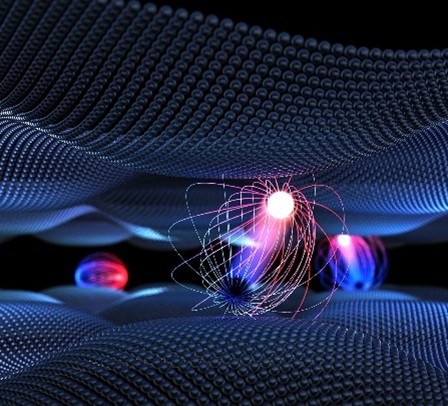Main Content
Research Topics and Projects
Fundamental properties of new materials

New classes of materials, like 2D materials and other quantum materials (semiconductors, nano-structures, photonic structures, meta-materials, carbon nanomaterials, functional molecules…) as well as heterostructures thereof offer unique properties and hence new possibilities for various applications. The understanding of structural, optical, dynamic, magnetic and transport phenomena associated with these structures builds the foundation for development of new applications. This is a highly interdisciplinary research topic, which needs the expertise across the disciplines of physics and chemistry in theory as well as in experiment. The entire process of knowledge acquisition from synthesis through characterization to application with industrial partners is mastered by a collaboration of groups in mar.quest. In doing so, more resource-efficient processes control and application of quantum processes in optics and electronics are envisioned as targets of the center.
Development of Novel Synthesis Routes
The development of new synthesis routes can yield fundamentally new functional molecules and materials with novel properties, with improved performance or reduced environmental impact. Functional molecules are, for example, state-of-the-art reagents and catalysts that enable sustainable synthetic methodologies in various fields of chemistry, biochemistry, and pharmacy. This includes stimuli-responsive, switchable processes, and the exploitation of photo-, mechano-, and electrochemical approaches. Functional molecules can show fluorescent behavior or carry chiral or magnetic information and thus be used towards storage media or in quantum information science. Specially designed molecules also include precursors for the targeted synthesis of novel materials such as semiconductor layers with specific properties. Furthermore, functional molecules can be of interest due to their optical properties and can be used, for example, in sensors or optoelectronic systems. All these approaches bear in common that the utilization of readily available elements that are associated with low costs and low toxicities is targeted. (Casitas, Lichtenberg, von Hänisch, Werncke).

Surface-assisted and gas phase-controlled synthesis, for example, can yield 0D quantum structures such as nanographenes, 1D graphene nanoribbons (GNRs), 2D materials, perovskites as well as organic and inorganic semiconductor structures and many more (Goldschmidt, Gottfried, Volz, Witte).
Rapid material prototyping by single-molecule and single-atom manipulation combined with atomic-scale characterization by scanning probe methods potentially provides access to completely new classes of materials (Gottfried). The understanding of the underlying reaction mechanisms of designed chemical precursors, surface properties, process dynamics, and structure of the resulting materials unlocks a huge range of new opportunities. New synthesis routes are also necessary for the development of environmentally friendly processes (green chemistry) and the use of new resources e.g. bio-sourced raw materials or materials from recycling flows.
Advanced Characterization and Theory
Employing spectroscopy and microscopy allows to decipher the quantum interactions and electronic structures that underpin materials (Gerhard, Goldschmidt, Gottfried, Koch, Leisgang, Reutzel, Volz, Witte). Only if nanoscale properties are correlated to application-relevant device characteristics, the materials´ potential in sustainable technologies can be harnessed and unprecedented properties can be achieved in turn. The center is hosting and developing beyond state-of-the-art characterization techniques to bridge the gap between fundamental research and technology.

Theory plays a central role in development of novel concepts and innovative approaches in quantum materials research. This ranges from prediction of new quantum phenomena and development of overall scaling relations via design of tailored molecular and material properties to proposal of novel pathways for synthesis and analysis, to name but a few of these general directions. Quantitative and predictive theory for molecules, materials and their fundamental interactions can subsequently be benchmarked via experimental realization and can shorten, in joint efforts, significantly empirical knowledge-gaining loops. mar.quest provides the environment for intense collaboration between theoretically oriented physicists and chemists, who design molecules, understand reactions and layer formation processes as well as structure and dynamics of novel materials from a theoretical point of view (Berger, Gebhard, Malic, von Domaros, Wippermann), on the one hand and their experimentally oriented colleagues on the other hand.
Novel and Sustainable Applications

New materials and knowledge will enable entirely new application and step-changes in the performance and the reduction of the environmental foot-print. Based on the existing strengths, the center will primarily focus on applications in the field of renewable energy generation and storage, especially solar cells, green hydrogen, fuel cells and battery materials as well as semiconductor technology for novel laser structures, solar cells and transistors (Goldschmidt, Kraus, Roling, Volz). The research will combine the outcomes of all the other research areas from understanding of new materials, synthesis, characterization and design to provide solutions for pressing societal needs. Here, also unconventional paths will be taken by e.g. understanding how CO2 fixation has worked in early earth´s geochemistry and translating this into sustainable approaches for CO2 fixation today (Preiner).